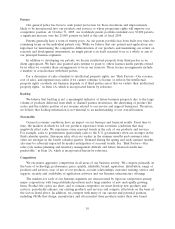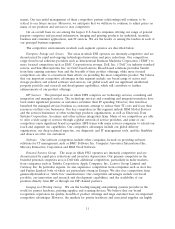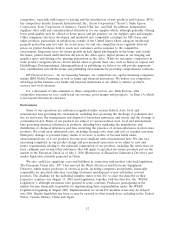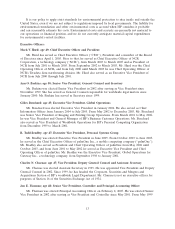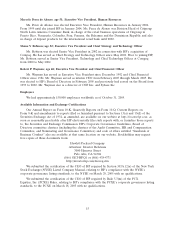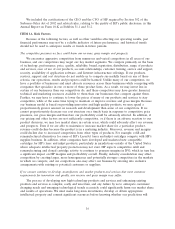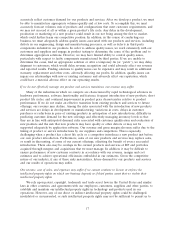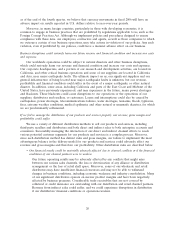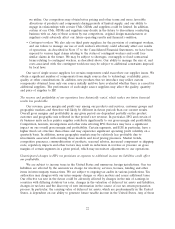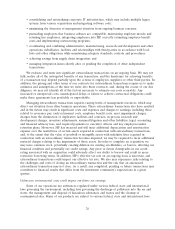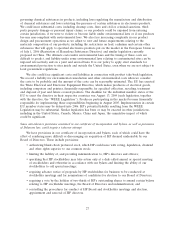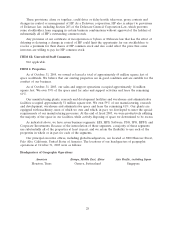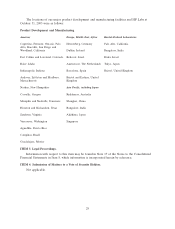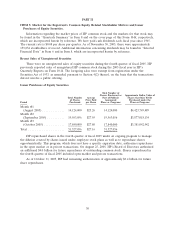HP 2005 Annual Report Download - page 24
Download and view the complete annual report
Please find page 24 of the 2005 HP annual report below. You can navigate through the pages in the report by either clicking on the pages listed below, or by using the keyword search tool below to find specific information within the annual report.as of the end of the fourth quarter, we believe that currency movements in fiscal 2006 will have an
adverse impact on results reported in U.S. dollars relative to year-over-year periods.
Moreover, in many foreign countries, particularly in those with developing economies, it is
common to engage in business practices that are prohibited by regulations applicable to us, such as the
Foreign Corrupt Practices Act. Although we implement policies and procedures designed to ensure
compliance with these laws, our employees, contractors and agents, as well as those companies to which
we outsource certain of our business operations, may take actions in violation of our policies. Any such
violation, even if prohibited by our policies, could have a material adverse effect on our business.
Business disruptions could seriously harm our future revenue and financial condition and increase our costs
and expenses.
Our worldwide operations could be subject to natural disasters and other business disruptions,
which could seriously harm our revenue and financial condition and increase our costs and expenses.
Our corporate headquarters, and a portion of our research and development activities, are located in
California, and other critical business operations and some of our suppliers are located in California
and Asia, near major earthquake faults. The ultimate impact on us, our significant suppliers and our
general infrastructure of being located near major earthquake faults is unknown, but our revenue,
profitability and financial condition could suffer in the event of a major earthquake or other natural
disaster. In addition, some areas, including California and parts of the East Coast and Midwest of the
United States, have previously experienced, and may experience in the future, major power shortages
and blackouts. These blackouts could cause disruptions to our operations or the operations of our
suppliers, distributors and resellers, or customers. Losses and interruptions could also be caused by
earthquakes, power shortages, telecommunications failures, water shortages, tsunamis, floods, typhoons,
fires, extreme weather conditions, medical epidemics and other natural or manmade disasters, for which
we are predominantly self-insured.
If we fail to manage the distribution of our products and services properly, our revenue, gross margin and
profitability could suffer.
We use a variety of different distribution methods to sell our products and services, including
third-party resellers and distributors and both direct and indirect sales to both enterprise accounts and
consumers. Successfully managing the interaction of our direct and indirect channel efforts to reach
various potential customer segments for our products and services is a complex process. Moreover,
since each distribution method has distinct risks and gross margins, our failure to implement the most
advantageous balance in the delivery model for our products and services could adversely affect our
revenue and gross margins and therefore our profitability. Other distribution risks are described below.
•Our financial results could be materially adversely affected due to channel conflicts or if the financial
conditions of our channel partners were to weaken.
Our future operating results may be adversely affected by any conflicts that might arise
between our various sales channels, the loss or deterioration of any alliance or distribution
arrangement or the loss of retail shelf space. Moreover, some of our wholesale and retail
distributors may have insufficient financial resources and may not be able to withstand
changes in business conditions, including economic weakness and industry consolidation. Many
of our significant distributors operate on narrow product margins and have been negatively
affected by business pressures. Considerable trade receivables that are not covered by
collateral or credit insurance are outstanding with our distribution and retail channel partners.
Revenue from indirect sales could suffer, and we could experience disruptions in distribution
if our distributors’ financial conditions or operations weaken.
20


